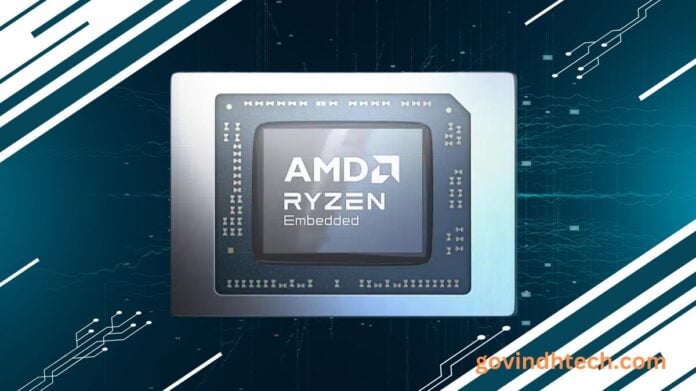AMD 8000 series CPU
AMD Ryzen Embedded
The AMD XDNA architecture-based AMD 8000 series processors are the company’s first embedded AMD processors to integrate conventional CPU and GPU components with NPUs. These processors are designed to be very versatile and adaptable for a wide range of workloads, particularly those related to industrial artificial intelligence. For many industrial AI applications, such as machine vision, robotics, and industrial automation, embedded solution engineers and developers may take use of the processing power and leading characteristics.
AI is now frequently utilised to improve quality control and inspection procedures in machine vision applications. Additionally, AI can assist robots in optimising their routes in real time and adjusting to changing conditions. Intelligent edge devices in industrial automation may carry out sophisticated analysis and decision-making without requiring cloud access thanks to AI processing. This enables autonomous control, predictive maintenance, and real-time monitoring of industrial operations, improving uptime and decreasing operating costs.
AMD 8000 series
AMD Ryzen 8000 series
As the first AMD Embedded devices to include XDNA architecture, the AMD Ryzen Embedded 8000 Series processors redefined performance standards in terms of processing speed, graphics delivery, and I/O connectivity among AMD industrial processing systems.
AI industrial computing efficiency has advanced significantly with AMD 8000 series processors’ performance-per-watt profile, which is enabled for industrial PCs and automation, machine vision, and robotics applications. A variety of thermal design power (TDP) profiles, ranging from 15W to 54W, are offered by the AMD Ryzen Embedded 8000 Series CPUs.
A top maximum performance of 16 trillion operations per second (TOPS) provided by the NPU is boasted by the processors within this range. It is a strong profile appropriate for demanding and varied industrial computing applications since the complete processor performance scales up to 39 TOPS. GPU-driven AI acceleration in CPU designs is being replaced by onboard NPU integration. Comparing NPUs to traditional parallel/matrix GPU coprocessing, better computational agility and lower power consumption are possible due to the focused, efficient acceleration of AI. A software development kit (SDK) that simplifies development and deployment flexibility at reduced costs, together with an open, royalty-free software ecosystem comprising libraries and inferencing models, are used to do this.
EFFICIENT AND INTEGRATED
In order to provide strong CPU performance and integrated AMD Radeon graphics in a BGA (FP7r2) package for effective, efficient industrial systems, AMD 8000 series processors use the next-generation “Zen 4” core architecture and AMD RDNA 3 graphics. At the industrial edge, quick and seamless AI inferencing and decision-making are made possible by AMD embedded solutions’ new onboard XDNA architectural feature.
This method provides specialised AI inferencing at the processor layer to serve use cases for robotics, machine vision, monitoring, and human-machine interfaces (HMI), while optimising processing and design efficiency. Strong AI inferencing is now possible in a roughly same power envelope because to these additional capabilities, which improve upon the performance-per-watt value of prior Ryzen Embedded Series CPUs.
RICH VISUALS AND I/O
AMD’s Ryzen Embedded 8000 Series CPUs provide plenty of I/O flexibility for specialised accelerators and other add-ons, with 20 lanes of on-chip PCIe Gen4. Along with support for error-correcting code (ECC) for dependable and effective memory transfer, AMD Ryzen Embedded 8000 Series Processors also come with the most recent dual-channel memory support (DDR5 up to 5600MT/s). In order to maximise visual processing and multimedia performance, AMD Ryzen Embedded 8000 Series processors provide potent x86 CPU computing with up to 8 “Zen 4” cores (16 threads).
Integrated AMD Radeon-class graphics also include the most recent AMD RDNA 3 technology. A solitary, compact AMD Ryzen Embedded 8000 Series CPU may drive four separate screens at 4K resolution by using hardware encoding and decoding for well-known video codecs like H.265 and AV1. The AMD Ryzen Embedded 8000 Processors contribute to the versatility of display and HMI setups in industrial systems that use graphical interfaces and status displays, even in areas with limited space and heat.
ACHIEVABLE AND OPEN
An excellent choice for industrial system OEMs looking to extend their AI support capabilities and product portfolios across a variety of performance, power, and graphics-optimized alternatives are AMD Ryzen Embedded 8000 Series CPUs due to their performance and power scalability. An extended design lifespan is supported by planned product availability of up to ten years. Easy access to royalty-free libraries and inferencing models via an open AI software ecosystem facilitates quicker development cycles for designers. Support for Microsoft Windows is provided via the software development kit that is offered. With pretrained models that are accessible on HuggingFace, it also supports well-known AI frameworks like PyTorch and TensorFlow.
AMD is working with Advantech, ASRock, and iBASE, among other embedded OEMs, to provide a wide range of cutting-edge platforms that will support AMD Ryzen Embedded 8000 Series CPUs with them. Long-term design lifecycles are further supported by AMD Ryzen Embedded Series CPUs, which have prolonged product availability.
AI opportunities in the embedded industry have expanded with the arrival of the AMD XDNA architecture and its potent AI engines in a few AMD Ryzen Embedded devices, ushering in an exciting new age for these applications.


